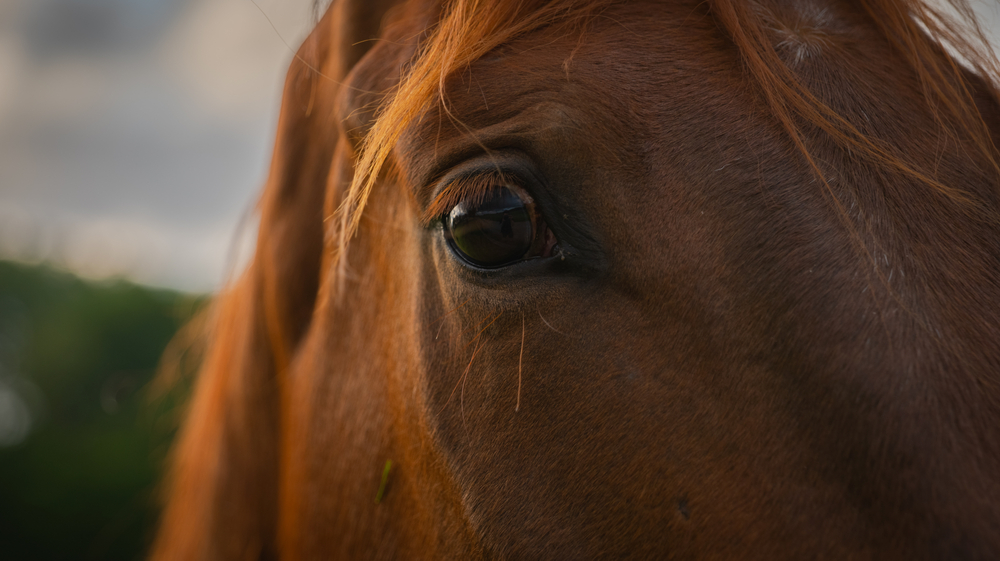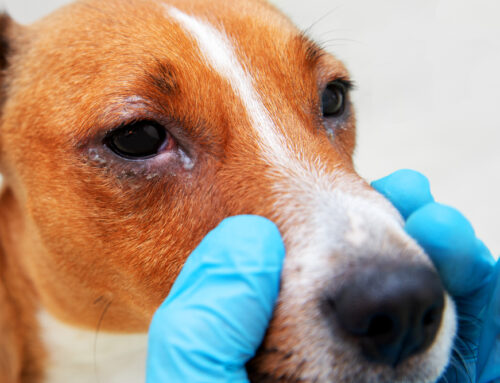The cornea is the protective, clear, outer eye covering that keeps the outside world out, while allowing light in. This tissue is vulnerable to injury because of its eye position and environmental exposure, which can result in corneal clouding or scarring that affects vision. Some corneal injuries heal on their own in a few days, but others may develop into a corneal abscess, which is a collection of immune cells and infectious organisms that becomes trapped in the interior corneal layers. In horses, corneal abscesses can be difficult to treat and may result in vision or eye loss, but specialty treatment from your Veterinary Vision Center’s ophthalmology team can help save your horse’s vision and restore their comfort.
Equine cornea and abscess anatomy
The equine cornea is about 1 mm thick, with several layers of different, specialized cell types. Corneal abscesses most commonly occur in the thickest interior layer (i.e., the stroma), disrupting the collagen structure, and causing a cloudy, discolored spot. Abscesses are usually caused by bacteria or fungi that invade through a minor outer corneal epithelium injury, which quickly heals over and traps the organisms inside. The organisms then proliferate, white blood cells collect in the area, and inflammation surrounds the abscess and causes a cloudy appearance. Horses can also develop corneal abscesses from whole-body systemic infections or immune system problems, but rarely.
Corneal abscess signs in horses
In the early stages, the abscess appears as a hazy white, tan, or yellow spot in the eye, and the horse may tear up or squint, and seem uncomfortable. In later stages, they may show the following in their eye:
- Blue-gray discoloration (i.e., corneal edema)
- Intense redness
- Blood vessel growth (i.e., vascularization)
- Inflammatory cells in the front (i.e., uveitis)
Corneal abscess complications in horses
Abscesses can quickly lead to vision-threatening complications from the eye inflammation. Any combination of these signs may ultimately lead to blindness:
- Parts of the eye sticking together (i.e., synechiae)
- High eye pressure (i.e., glaucoma)
- Retinal detachment
- Eye “death” or shrinkage (i.e., phthisis bulbi)
If abscess organisms are resistant to treatment and proliferate into deeper corneal layers, the eye can rupture completely, which also risks blindness.
Corneal abscess medical treatment in horses
Early, aggressive intervention is necessary for successful corneal abscess treatment. First-line treatment includes topical antibacterial and antifungal medications administered multiple times per day for several weeks or months. Caretakers may find topical medical therapy too intensive, so hospitalization or subpalpebral lavage system placement can be helpful. Systemic anti-inflammatory medications can also reduce intraocular inflammation and complications.
Additional measures that can help protect the injured eye during treatment include:
- Feeding hay from the ground only, and not from overhead racks
- Covering the eye with a fly mask
- Limiting exercise
- Keeping the horse in a darkened stall
Corneal abscess surgical treatment in horses
When abscesses don’t respond to medical therapy, or are too dense or thickened to allow medication penetration, large, or deep in the cornea, surgical treatment is recommended. Surgery may also be recommended for performance horses, for possible quicker recovery and reduced scarring. Surgical approaches vary, but generally involve removing the affected cornea, and patching the area with corneal or conjunctival tissue, if needed. Minor procedures that remove only the top cell layer may be performed with the horse sedated, but more involved surgeries require general anesthesia.
Long-term outcome for horses with corneal abscess

With successful medical or surgical treatment, fibrosis will result in a white scar. Scars on the corneal periphery are unlikely to affect vision or performance, but large or central scars can impact some degree of vision. Most cases can be successfully treated, providing comfort and abscess healing, but blindness can result from complications. Eye removal is rarely required, but may be recommended for severe, non-responsive, painful cases.
Equine corneal abscess treatment can be challenging, but your Veterinary Vision Center team can help you achieve the best outcome possible. Call us to schedule an appointment if you notice any changes to your horse’s eyes or vision, or if you need assistance with ongoing treatment.







Leave A Comment